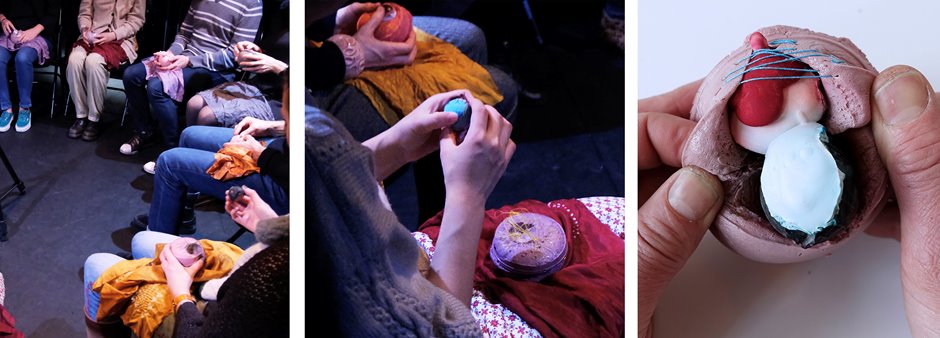The Aesthetics of Touch
“The impact of touch is enormous”
Artist and HKU lecturer Marloeke van der Vlugt studies the value of tactile senses. Her PhD study on the human sense of touch in – and by - the arts is part of a pilot by HKU and the University of Humanistic Studies. In the current time when human touch is mostly associated with risks and taboo, she is actually searching for ways to activate our tactile sensations.

Aesthetic distance
The tactile sense is one of the most important senses we are born with. Yet while babies simply grab everything and put it in their mouth, we are rapidly taught not to. ‘Don’t touch that’ is one of the most-heard expressions in our younger years. And the arts take that commandment to the extreme. It promotes aesthetic distance, where listening and looking have the most prominent role. In museums, all objects are neatly in stored in class cabinets and performances have the audience seated at safe distance from the actors. All this while there is hardly a more direct and impactful experience than touch. Van der Vlugt commits herself to a restoration. For her audience, and for herself as creator as well. “How can I touch this world and how does the world touch me.”
Research via creation
The Aesthetics of Touch is an ‘artistic research PhD’: a pilot in which HKU cooperates with University of Humanistic Studies to enable PhD research. For this study of tactility in and by the arts, Van der Vlugt receives a Doctoral Grant for Teachers from the Dutch Research Council NWO, which partly relieves her of her regular teaching work. “The innovative aspect of artistic research is that you study by creating and sharing things”, Van der Vlugt explains. This begins with her own artistic practice, for which she searches for a tactile creation process with unpredictable sculpting materials and techniques. The artefacts brought forth by this, such as the little polyurethane globes with their mysterious contents of naturally dyed gypsum, are then shared with her audience in interactive performances. This doesn’t even require their physical presence per se. “In the pandemic, I also worked on activating the haptic eye remotely. Because even a viewing experience can manifest itself as touch.”
No words for it
The performances also serve as experiments, while Van der Vlugt observes the participants to gather data. The objects, occurrences and reactions to it, are thoroughly documented in a ‘living archive’. Van der Vlugt is currently working on the video documentary of the performance Thresholds of Touch, that she developed together with Professor Carey Jewitt’s IN-TOUCH lab. “This collaborative experiment is a cross-over between sociology and the arts. Carey knows a lot about touch in the social domain. Yet she was looking for a way to get people to describe how they experience touch, because they often find it hard to put it into words. By approaching the session in an artistic way, we managed to collect a lot of information about this.” The unwrapping of the little foam balls was an important part of this ‘haptic exploration’, which also included interpersonal touch, the sensation of water on your skin, and the ‘feeling’ of sound and motion.
Bandage
In one of the papers that she regularly publishes, Van der Vlugt states: “My research is about the potential role of the tactile senses in the creation of an experience that explores the mutual relation between humans and all kinds of matter”. The element of reciprocity was also strongly emphasised in another experiment; one that was a cross-over with healthcare. Van der Vlugt participated in the partner project between HKU and Amsterdam Medical Centre: In Search of Stories. Its goal is to help patients with cancer find meaning via artistic imagination. As artist, she started a dialogue with one participant through the bandage that was wrapped around her arm after each chemotherapy. They put this bandage in a wholly different context. By touching and unravelling it, the bandage transformed into an object that has a new meaning: a necklace to wear or a piece of art to put on the wall. “By treating the bandage with so much care and sensitivity, and manipulating them in an artistic way, it created a personal and intimate interaction that gave a wholly different feel.”

Partners
HKU University of the Arts Utrecht (HKU), University of Humanistic Studies, IN-TOUCH lab University College London, Uniarts Helsinki
Lecturing esearchers HKU
Marloeke van der Vlugt – associated with HKU Theatre (IPD and MA Scenography), researcher at professorship Performative Creative Processes.
Supported by
Dutch Research Council (NWO)
More information
Want to know more about The Aesthetics of Touch? Please contact Marloeke van der Vlugt:
marloeke.vandervlugt@hku.nlwww.marloekevandervlugt.com
research catalogue